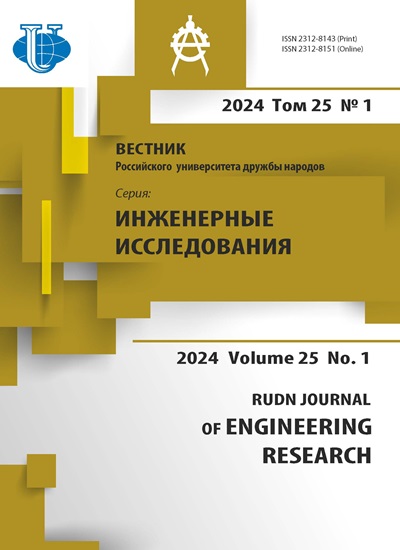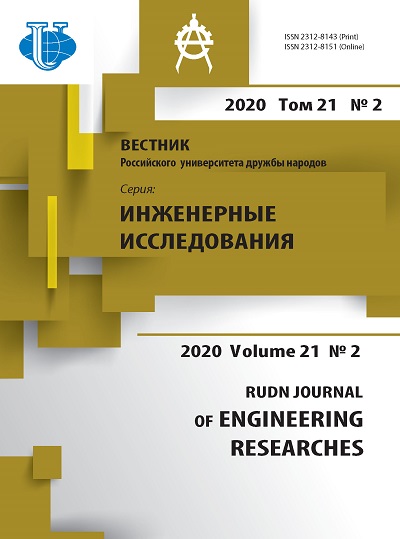Effect of fixing the pass-through turning tool in the tool holder on the roughness and surface macro deviations during turning
- Authors: Allenov D.G.1, Deinova K.B.1, Solomatin S.V.1, Lazarenko O.I.1
-
Affiliations:
- Peoples’ Friendship University of Russia (RUDN University)
- Issue: Vol 21, No 2 (2020)
- Pages: 105-112
- Section: Mechanical engineering and power-plant
- URL: https://journals.rudn.ru/engineering-researches/article/view/25548
- DOI: https://doi.org/10.22363/2312-8143-2020-21-2-105-112
Cite item
Full Text
Abstract
The scientific work represents a research of the cutting process in order to determine the influence of the cutting tool extension’s length from the tool holder and the cutting forces that occur during processing and corresponding to different values of the removed layer on the formation of the quality of the surface layer of parts during turning. As a cutting tool, the research used a PCLNR2525M12 straight-turning tool with replaceable T15K6 carbide inserts. Steel cylindrical workpieces with a diameter D = 40 mm (steel grade - 30) were used as workpieces. Cutting was carried out at three different cutting depths: 0.4, 1, 1.5 mm. The feed rate and spindle speed throughout the experiment were constant and were equal to s = 0.1 mm/rev, n = 1000 rpm, respectively. The geometric deviations of the cutter from the theoretical cutting line were determined by mathematical modeling methods. Linear displacements formed due to the stress-strain state of the cutter were used as estimated parameters. The study presents the methodology for preparing and conducting mathematical modeling using the three-dimensional modeling system KOMPAS-3D and APM FEM module. The roughness parameters that occur during turning by cutters with different tool extension with different cutting modes were studied experimentally.
About the authors
Dmitry G. Allenov
Peoples’ Friendship University of Russia (RUDN University)
Author for correspondence.
Email: allenov-dg@rudn.ru
Ph.D., Assistant of Department of Mechanical Engineering and Instrument Engineering of Academy of Engineering of RUDN University
6 Miklukho-Maklaya St, Moscow, 117198, Russian FederationKristina B. Deinova
Peoples’ Friendship University of Russia (RUDN University)
Email: allenov-dg@rudn.ru
undergraduate student of Department of Mechanical Engineering and Instrument Engineering of Academy of Engineering of RUDN University
6 Miklukho-Maklaya St, Moscow, 117198, Russian FederationSergey V. Solomatin
Peoples’ Friendship University of Russia (RUDN University)
Email: allenov-dg@rudn.ru
master student of Department of Mechanical Engineering and Instrument Engineering of Academy of Engineering of RUDN University
6 Miklukho-Maklaya St, Moscow, 117198, Russian FederationOlga I. Lazarenko
Peoples’ Friendship University of Russia (RUDN University)
Email: allenov-dg@rudn.ru
master student of Department of Mechanical Engineering and Instrument Engineering of Academy of Engineering of RUDN University
6 Miklukho-Maklaya St, Moscow, 117198, Russian FederationReferences
- Suslov AG. Inzheneriya poverkhnosti detaley [Part surface engineering]. Moscow: Mashinostroenie Publ.; 2008. (In Russ.)
- Grigorev SN, et al. Rezanie materialov. Rezhushchij instrument [Cutting materials. Cutting tool] (part 1). Moscow: Yurajt Publ.; 2020. (In Russ.)
- Bezyazychnyy VF. Vliyaniye kachestva poverkhnostnogo sloya posle mekhanicheskoy obrabotki na ekspluatatsionnyye svoystva detaley mashin [The influence of the quality of the surface layer after machining on the performance properties of machine parts]. Engineering Journal. 2000;(4): 9–16. (In Russ.)
- Kozochkin M, Allenov D, Andryushchenko IS. Use of vibro-acoustic monitoring for stabilization stress-strain state of surface layer of workpiece during cutting. Lecture Notes in Mechanical Engineering: Proceedings of 4th International Conference on Industrial Engineering 2018. 2018. p. 1355–1363. (In Russ.) doi: 10.1007/978-3-319-95630-5_143.
- Allenov DG. Issledovaniye vliyaniya iznosa rezhushchey kromki instrumenta na chistotu poverkhnosti [Study of the effect of wear of the cutting edge of the tool on the surface cleanliness]. Mechanical Engineering. 2016;4(16):12–16. (In Russ.)
- Thomas M. Effect of tool vibrations on surface roughness during dry turning. Computers & Industrial Engineering. 1996;31(3–4):637–644. doi: 10.1016/s0360- 8352(96)00235-5.
- Rogov VA, Gorbani S. Influence of the handle design on a composite lathe cutter. Russian Engineering Research. 2013;11(3):435–440. (In Russ.) doi: 10.3103/ s1068798x15010220.
- Allenov DG. Issledovaniye vliyaniya kachestva poverkhnostnogo sloya na ekspluatatsionnyye kharakteristiki detali [The study of the influence of the quality of the surface layer on the performance characteristics of the part]. Scientific and Technical Bulletin of the Volga region. 2018;(6):30–34. (In Russ.)
- Markova TV, Kryzhanovskaya IM. Sherokhovatost’ poverkhnosti [Surface Roughness]. Saint Petersburg: Polytechnic University Press; 2006. (In Russ.)
- Lim T. Optimization of tool selection. International Journal of Production Research. 2001;39(6):1239–1256.
- Dalsky AM, Kosilova AG, Meshcheryakov RK, Suslov AG. Spravochnik tekhnologa-mashinostroitelya [Reference Book of Technologist-Mechanical Engineer]. Moscow: Mashinostroenie Publ.; 2001. (In Russ).
- Parfeneva IE. Tekhnologiya konstruktsionnykh materialov. Obshchaya kharakteristika obrabotki rezaniyem [Technology of construction materials. General characteristics of machining]. Moscow: Mashinostroenie Publ.; 2012. (In Russ.)
- Ambati R, Yuan H. FEM mesh-dependency when modeling the cutting process. International Journal of Advanced Manufacturing Technology. 2011;53(1–4):313–323. doi: 10.1007/s00170-010-2818-9.
- Wolf AM. Rezaniye metallov [Metal cutting]. Leningrad: Mashinostroenie Publ.; 1973. (In Russ).
- Korsakov VS. Tochnost mekhanicheskoy obrabotki [Accuracy of machining]. Moscow: Mashgiz Publ.; 1961. (In Russ.)
- Allenov D, Kozochkin M, Andryushchenko IS. Monitoring of the stress-strain state of the surface layer of a part in the cutting process using vibroacoustic diagnostics. MATEC Web of Conferences. 2017:129. doi: 10.1051/ matecconf/201712901032.
- Chen JC, Chen WL. Tool failure detection system using an accelerometer sensor. Journal of Intelligent Manufacturing. 1999;10(2):187–197. doi: 10.1023/A:1008980821787.
















